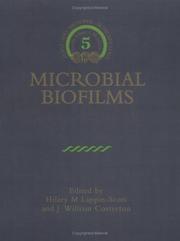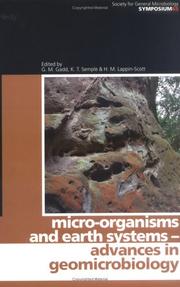| Listing 1 - 4 of 4 |
Sort by
|
Book
ISBN: 0511525354 Year: 1995 Publisher: Cambridge : Cambridge University Press,
Abstract | Keywords | Export | Availability | Bookmark
 Loading...
Loading...Choose an application
- Reference Manager
- EndNote
- RefWorks (Direct export to RefWorks)
The formation of microcolonies on surfaces is an important bacterial survival strategy. These biofilms occur on both inert and living systems, making them important to a wide range of scientific disciplines. This book first provides an analysis of the chemical, ecological and physical processes involved with the development of biofilms and their interactions with surfaces. The next section deals with biofilms on non-living surfaces. Biofilms have important engineering implications, such as in mining industries, the corrosion of pipelines and pure and waste water industries. Biofilms have medical significance when associated with the mouth, urinary tract and urinogenital tract. In addition, they form in plant root systems and in animals, such as the ruminant digestive tract, and so are agriculturally important. The final section examines these interactions with living surfaces.

ISBN: 9780511525353 9780521454124 9780521542128 Year: 1995 Publisher: Cambridge Cambridge University Press
Abstract | Keywords | Export | Availability | Bookmark
 Loading...
Loading...Choose an application
- Reference Manager
- EndNote
- RefWorks (Direct export to RefWorks)

ISBN: 9780511754852 9780521862226 0511141300 9780511141300 051114122X 9780511141225 0521862221 1107156599 1280955708 9786610955701 1139131850 0511351216 0511140983 051175485X 9781107156593 9781280955709 6610955700 9781139131858 9780511351211 9780511140983 Year: 2005 Publisher: Cambridge Cambridge University Press
Abstract | Keywords | Export | Availability | Bookmark
 Loading...
Loading...Choose an application
- Reference Manager
- EndNote
- RefWorks (Direct export to RefWorks)
There is growing awareness that important environmental transformations are catalysed, mediated and influenced by microorganisms, and geomicrobiology can be defined as the influence of microorganisms on geologic processes. This is probably the most rapidly growing area of microbiology at present, combining environmental and molecular microbiology together with significant areas of mineralogy, geochemistry and hydrology. This volume focuses on the function of microorganisms in the environment and their influence on 'global' processes. It will include state-of-the art approaches to visualisation, culture and identification, community interactions and gene transfer, and diversity studies in relation to key processes. This overview for researchers and graduate students will represent environmental microbiology in its broadest sense and help to promote exciting collaborations between microbiologists and those in complementary physical and chemical disciplines.
Geomicrobiology --- Microorganisms --- Germs --- Micro-organisms --- Microbes --- Microscopic organisms --- Organisms --- Microbiology --- Geological microbiology --- Microbiological geology --- Geobiology --- General microbiology --- Earth systems

ISBN: 9780511754913 9780521869355 9780511226502 0511226500 0511754914 1280550597 9781280550591 0521869358 1107156726 9786610550593 0511225938 0511224656 0511322569 0511225326 Year: 2006 Publisher: Cambridge Cambridge University Press
Abstract | Keywords | Export | Availability | Bookmark
 Loading...
Loading...Choose an application
- Reference Manager
- EndNote
- RefWorks (Direct export to RefWorks)
The true extent of prokaryote diversity, encompassing the spectrum of variability among bacteria, remains unknown. Current research efforts focus on understanding why prokaryote diversification occurs, its underlying mechanisms, and its likely impact. The dynamic nature of the prokaryotic world, and continuing advances in the technological tools available make this an important area and hence this book will appeal to a wide variety of microbiologists. Its coverage ranges from studies of prokaryotes in specialized environmental niches to broad examinations of prokaryote evolution and diversity, and the mechanisms underlying them. Topics include: bacteria of the gastrointestinal tract, unculturable organisms in the mouth and in the soil, organisms from extreme environments, the diversity of archaea and their phages, comparative genomics and the emergence of pathogens, the spread of genomic islands between clinical and environmental organisms, minimal genomes needed for life, horizontal gene transfer, phenotypic innovation, and patterns and extent of biodiversity.
Geomicrobiology --- Geobiology. --- Biology --- Earth sciences --- Biosphere --- Geological microbiology --- Microbiological geology --- Geobiology --- Microbiology --- Microbial diversity --- Prokaryotes --- Genetics --- Monera --- Procaryotae --- Procaryotes --- Prokaryonta --- Prokaryotae --- Prokaryotic protists --- Microorganisms --- Diversity, Microbial --- Microbiodiversity --- Microbiological diversity --- Biodiversity
| Listing 1 - 4 of 4 |
Sort by
|

 Search
Search Feedback
Feedback About UniCat
About UniCat  Help
Help News
News